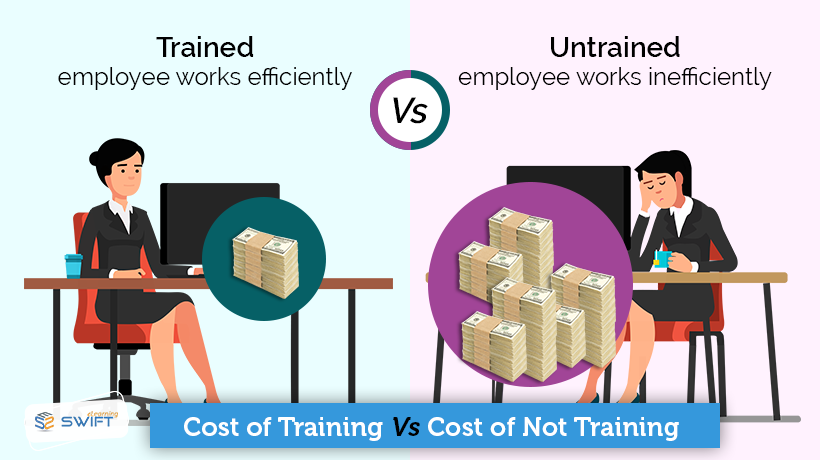Cost of Training Vs. Cost of Not Training
Human resources are the drivers of organization’s business endeavors. They cause business to win new opportunities and help grow further. Eventually, they also impact negatively on business results. Smart businesses recognize this critical constituent and act to turn it in their favor. So, the important question is ‘What is that they do to achieve it?’
The answer is: ‘Workforce training is the only idea which helps them’.
“Training is the most effective and efficient instrument to make an impactful change in the workforce performance making a company grow.”
In many organizations, training is often abandoned due to unsustainable reasons of Cost.
In this blog, I will try to put forth rationale to convince that “Not Training” can cost significantly higher than the Training Cost.
The Cost of Training
Of course, employee training is an investment driven affair in any organization. It incurs significant cost and efforts to execute it for the best business results. No matter in what stage your company is operating; whether it is a developed business, developing business or just a start-up; training is a fuel as like as a capital to take your company’s vision forward.
The Cost of Not Training
The untrained or less competent resource may impact negatively on business results. For example, a less skilled resource may cause company’s client to frustrate by their poor quality work, communication and work style. Moreover, they may fail to win new prospects too.
Simply put, sooner or later, The Cost of Not Training will exceed The Cost of Training.
Why Organizations are Reluctant to Invest in Training?
Companies show readiness to select and pay more to a person who is already trained. He/She may have received training in areas such as full-time academic education, vocational training, certificate courses or on-the-job (informal) training.
If the above case is true, then a question to be answered is: ‘Why companies nag to invest on a candidate after recruitment?’
Hopefully, following could be the answers:
- What if an employee receives training and then quit for higher pay?
- Training is not employer’s responsibility; if they want to grow they will take care of themselves.
- Training is not important; people will learn when they are made responsible for the job.
- Training drags productive time.
If anyone or all the above are the reasons people have for not investing in training: I would request to read these quotes and rethink:
“One thing worse than training employees and losing them is not training them and keeping them.”
— Zig Ziglar
“Investing on a new candidate is more risker than the investing on the old employee”
— Anonymous
“An investment in education always pays the highest returns.”
— Ben Franklin
“Over the long run, superior performance depends on superior learning.”
— Peter Senge
“Provide medical examinations and training when required by OSHA standards.”
— Under OSHA Law
“As an employer, you are legally obliged to make sure your staff are trained to do their jobs safely. Certain industries also require specific training. Remember to keep a record of any training your staff complete.”
— Employer’s Obligations from Queensland Government
Training can also Address Employee Retention and Loyalty Issues Effectively
Besides performance, employee loyalty and retention are two major benefits that can be achieved via employee training.
Investing in training can turn into an effective welfare policy to improve employee retention and loyalty. Unconditional or limited condition financial offer can be made to resources to get trained.
Conclusion
When compared to the cost of training with the cost of not training, it is obvious that the cost of training is very less and provides peace and freedom to flourish your business ethically and legally correct.
Our Services: eLearning Service Provider, PowerPoint to eLearning, Flash to HTML5 Migration



It would be nice if you cited specific real life examples. This is probably not applicable to most companies in America where investment in their people is often seen as the smartest thing to do. This article seems more of a solution looking for a problem.
Thank you Don for the comment.
You are true, as in the US, the other countries too have good number of companies that spend significant budget on training. With this article, we are trying to address the concerns of those who still hesitate to invest on training.
I believe the question is where to draw the line, cost-wise. What is an appropriate amount and why? Should it be the same, regardless of position and individual performance?
Hi Radu Burducea,
Thank you so much for your well thought-out comments. Though cost of the training is an investment in itself; still, we must have certain limits. And, as you said, we must know where to draw the line. Here are my consideration on training budget allocation.
Department wise (high to low allocation of the budget) – Development Team, Management Team and Support Team
Based on the current state of the individual commitment towards the organization – Regardless of the seniority, organizations should invest more on the person who demonstrates high commitments.
Similarly, there are few other considerations. However, the ultimate goal is to support the individual or the team that requires grooming for achieving organizational success.
On the other side, I would also like to allocate a significant budget on non-performing resources to address lack of skills, personal issues even behavioral problems.
It’s interesting that you talk about the costs of training are far outweighed by the benefits. It makes sense that the employee retention and knowledge that can be achieved with training would make a business operate much more smoothly and quickly over time. This is something to remember because getting the training system down could help reduce the costs, particularly by staying organized to keep it short.